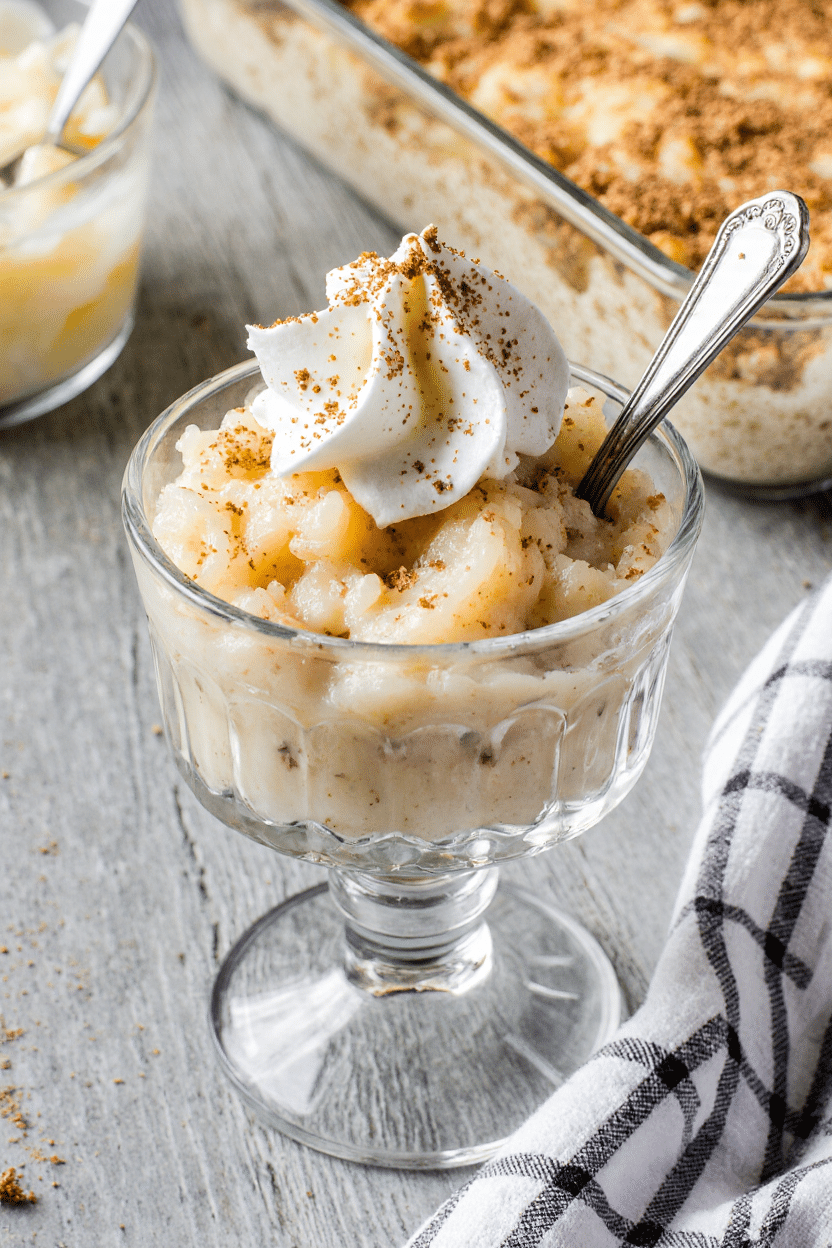The nostalgic aroma of cinnamon and vanilla fills the kitchen as this Irish Rice Pudding bakes to perfection in the oven. Known for its rich, velvety texture and traditional charm, this dessert brings together simple ingredients in the most comforting way. Each spoonful offers a warm, spiced flavor that wraps you in cozy satisfaction.
This baked rice pudding is a perfect dish to enjoy on a rainy day, around the holidays, or anytime you crave something wholesome and sweet. You can top it with a sprinkle of nutmeg, a drizzle of cream, or a handful of raisins for extra indulgence. It’s a timeless dessert that’s both humble and heartwarming, made to be shared and savored.
Full Recipe
Ingredients:
-
4 cups whole milk
-
½ cup white rice (short-grain or Arborio)
-
¼ cup granulated sugar
-
2 large eggs
-
1 teaspoon vanilla extract
-
½ teaspoon ground cinnamon
-
¼ teaspoon salt
-
2 tablespoons unsalted butter
-
Optional toppings: raisins, nutmeg, fresh cream, or brown sugar
Directions:
-
Preheat oven to 325°F (163°C).
-
In a large saucepan over medium heat, combine the milk, rice, sugar, butter, and salt.
-
Stir frequently and cook until the mixture is warm and the sugar is dissolved.
-
In a separate bowl, whisk the eggs. Slowly temper the eggs by adding a few tablespoons of the warm milk mixture into the eggs while stirring constantly.
-
Gradually add the tempered eggs back into the milk and rice mixture, stirring constantly to prevent curdling.
-
Remove from heat and stir in the vanilla extract and ground cinnamon.
-
Pour the mixture into a greased baking dish and cover with foil.
-
Bake in the preheated oven for 45-50 minutes, or until the pudding is set but still slightly creamy.
-
Let cool slightly before serving. Serve warm or chilled, topped with your favorite garnish.
Prep Time: 10 minutes | Cooking Time: 50 minutes | Total Time: 1 hour
Kcal: 265 kcal | Servings: 6 servings
The Rich History of Irish Rice Pudding
Irish Rice Pudding is a timeless dessert that embodies warmth, simplicity, and comfort. Though rice isn’t native to Ireland, this pudding has found its way into traditional Irish kitchens due to trade routes established centuries ago. Imported ingredients like rice and sugar became staples in the 18th and 19th centuries, especially in Anglo-Irish households. Over time, the dish evolved and became beloved across all social classes for its affordability and ease of preparation. Today, it stands as a rustic yet elegant dessert that reflects both Ireland’s resourcefulness and its appreciation for homestyle cooking.
This classic pudding blends rice, milk, eggs, sugar, and a touch of spice to create a creamy custard that’s often baked until golden. Vanilla and cinnamon are commonly used to elevate the flavor, while raisins or nutmeg may be added for extra depth. It’s an endearing treat, one that offers comfort during cold weather and festive family gatherings. The fact that it can be served either warm or cold makes it an ideal dessert year-round.
Why Irish Rice Pudding Stands Out
One of the key features that sets Irish Rice Pudding apart from similar desserts around the world is its baked preparation. While many rice puddings are cooked entirely on the stovetop, the Irish version is usually oven-baked, giving it a denser, custard-like texture. This baking process also results in a delightful, slightly browned top layer that adds a hint of caramelization and a beautiful contrast to the creamy interior.
Additionally, Irish Rice Pudding highlights the use of simple, wholesome ingredients, which is a hallmark of Irish cuisine. It’s this minimalism that allows the flavors of dairy, spice, and rice to truly shine. The recipe is also flexible—variations can include clotted cream, dried fruit, or even a splash of Irish whiskey for a decadent twist.
Cultural Significance in Irish Homes
Irish Rice Pudding isn’t just food; it’s a representation of family, tradition, and community. It’s the type of dessert that grandmothers pass down to their grandchildren, and it often holds sentimental value during family meals. It’s especially popular during the colder months when hearty, warming desserts are most appreciated. Served after a traditional Irish stew or roast, it completes the meal with comforting sweetness.
In rural communities, this dish symbolized frugality and resourcefulness. Families made use of what they had—milk from the farm, eggs from the coop, and imported rice bought in bulk. This made rice pudding not only a nourishing dessert but also an emblem of sustainability and creativity in the kitchen.
Modern-Day Appeal and Adaptability
Even as culinary trends change and global cuisine becomes more accessible, Irish Rice Pudding has maintained its place in the hearts of home cooks. It’s increasingly being rediscovered by new generations interested in traditional foods and nostalgic cooking. It’s also popular among people seeking gluten-free or egg-free desserts, thanks to the ability to modify the ingredients to suit dietary needs.
Some cooks now infuse the milk with herbs like lavender or citrus zest for a modern twist. Others swap dairy milk with almond or coconut milk for a vegan option. Despite these innovations, the pudding retains its humble Irish essence—a soft, soothing, and subtly sweet dish that invites customization without compromising its identity.
Perfect Occasions to Serve It
Irish Rice Pudding is one of those desserts that fits nearly every occasion. It’s light enough to serve after a hearty main dish and rich enough to stand alone as a satisfying sweet. During St. Patrick’s Day celebrations, it becomes a natural dessert choice. When paired with a drizzle of honey or a dash of whiskey cream, it’s elevated into a dinner party-worthy treat.
Its simplicity also makes it a perfect everyday dessert, something you can whip up with pantry staples for a spontaneous nightcap or a comforting snack. It’s equally delightful packed into a lunchbox, served at brunch, or offered as a sweet ending to a Sunday roast.
Tips for the Best Irish Rice Pudding
For the most luscious results, the quality of ingredients makes a significant difference. Whole milk delivers a creamier texture than low-fat versions. Using a high-starch rice like Arborio or pudding rice helps achieve the right consistency without requiring thickeners. Tempering the eggs correctly when incorporating them into the warm milk mixture is essential to avoid curdling and ensure a smooth custard.
Baking the pudding covered ensures that the rice cooks evenly and absorbs the sweetened milk mixture thoroughly. Removing the foil toward the end of baking allows the top to caramelize slightly, adding another layer of flavor and texture. Letting the pudding rest after baking helps it firm up and makes it easier to serve.
Common Variations and Regional Touches
While the classic Irish Rice Pudding is straightforward, regional and personal variations abound. In some households, a pinch of nutmeg or clove replaces or complements cinnamon. Others might stir in sultanas, golden raisins, or finely chopped dried apricots. Occasionally, it’s topped with a brûléed sugar crust or served alongside stewed fruit for a tart contrast.
In coastal areas or larger cities, where access to ingredients was broader, the dessert might include a splash of cream or sweetened condensed milk. In more rustic areas, it was often made without eggs, relying on longer baking times to achieve the right texture.
Pairing Suggestions
Irish Rice Pudding pairs wonderfully with beverages like Irish breakfast tea or a glass of cold milk. For a more refined dessert experience, serve it with a glass of Irish cream liqueur or a small pour of aged whiskey. Fruit toppings such as poached pears, berry compote, or even spiced apples enhance the flavor profile and add visual appeal.
If served as part of a larger dessert spread, it complements other Irish treats like soda bread with butter and jam, apple tart, or treacle scones. Its mild flavor makes it a versatile addition to any dessert lineup.
Nutritional Value and Dietary Considerations
This dish is relatively balanced in terms of macronutrients, offering carbohydrates from the rice, protein from the eggs, and fat from the dairy. It provides calcium and essential vitamins from the milk and eggs. For those watching sugar intake, the amount can be reduced or replaced with natural sweeteners like honey or stevia.
For gluten-sensitive individuals, Irish Rice Pudding is naturally gluten-free, provided all ingredients are cross-contamination-free. To make it dairy-free, substitute plant-based milks and skip the butter or use a vegan alternative. It’s also adaptable for egg-free diets with cornstarch as a thickening agent or using egg replacers available commercially.
Conclusion
Irish Rice Pudding is more than just a humble dessert—it’s a cultural staple, a nostalgic favorite, and a canvas for both tradition and creativity. Its charm lies in its simplicity and versatility. Whether you prepare it as it’s been made for generations or add your own contemporary spin, this pudding always delivers warmth and comfort in every bite.
From its origins in early Irish kitchens to its presence on modern dessert tables, Irish Rice Pudding continues to be a beloved dish that bridges the past and present. It’s proof that some of the best recipes are those that require little more than time, care, and a few pantry staples. As you serve it to family and friends, you’re not just offering dessert—you’re sharing a bit of Irish heritage, one creamy spoonful at a time.






